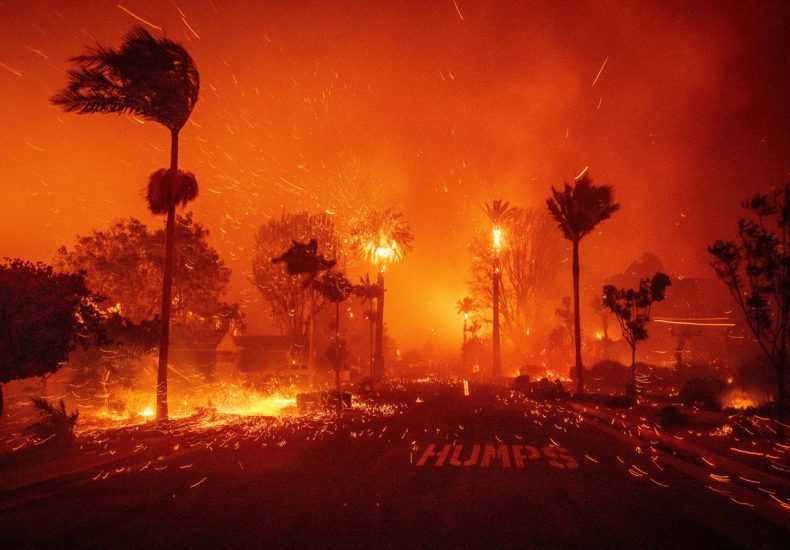
Wind Gusts Intensify Los Angeles Wildfires
Wind Gusts Fuel Los Angeles Wildfires, Prompting Urgent Response
Wildfires in Los Angeles have escalated in severity due to powerful wind gusts, forcing firefighters and emergency responders to race against time to control the flames. As conditions worsen, strong winds are causing the fires to spread quickly across neighborhoods, threatening lives, homes, and critical infrastructure.
This outbreak of wildfires comes during California’s peak fire season, and the high winds have only amplified the already volatile situation. With evacuation orders in place for many residents, authorities are urging the public to remain vigilant and stay informed as the situation continues to develop.
How Wind Gusts Affect Wildfire Behavior
The spread of wildfires is heavily influenced by wind conditions. Wind gusts, which can reach speeds of up to 50 miles per hour in some areas, significantly increase the rate at which fires move, making it harder for emergency crews to contain them. Wind not only pushes flames through dry vegetation but also carries embers across large distances, sparking new fires in areas that might otherwise remain unaffected.
This dangerous combination of dry weather, gusting winds, and low humidity creates the perfect environment for fires to explode in size and intensity. Experts have warned that this year’s wildfire season could be one of the worst in recent history, particularly with climate change contributing to longer, more extreme fire seasons.
Evacuation Orders and Emergency Response
As of today, multiple areas in Los Angeles County have been placed under mandatory evacuation orders, with thousands of residents being told to leave their homes immediately. Local authorities have set up emergency shelters, but many evacuees are being urged to find alternate accommodation due to the overwhelming demand.
Firefighters have been working around the clock, with thousands of personnel mobilized from across the state to assist in the effort. Despite their best efforts, the unpredictable nature of the wind gusts is complicating their mission. Firefighters are focusing on protecting homes, businesses, and critical infrastructure while trying to prevent the flames from reaching densely populated urban areas.
Air Quality and Health Risks
The rapid spread of the fires has caused poor air quality in many parts of Los Angeles. Residents are advised to stay indoors as much as possible, especially those with respiratory conditions, such as asthma or COPD, as the thick smoke poses serious health risks. Schools and outdoor activities have been suspended in some areas due to the hazardous air conditions.
Officials are also warning that the smoke could travel for hundreds of miles, affecting air quality as far away as neighboring cities and even other states. Public health experts have called on individuals to limit exposure and take preventive measures, such as wearing N95 masks, if they need to go outside.
Firefighters Battle Multiple Fronts
With the wind gusts intensifying and temperatures remaining high, fire crews are being stretched thin. Many firefighters are working in challenging conditions, often battling blazes on multiple fronts simultaneously. Firefighting aircraft, including water bombers and helicopters, are being deployed to assist in containing the flames, but the air support can only do so much when the winds are so unpredictable.
The city is also facing the challenge of limited resources, as wildfires continue to burn across various regions in California. Emergency teams from neighboring states have been called in to assist with firefighting and relief efforts.
The Long-Term Impact of Wildfires
Beyond the immediate threat to lives and property, the wildfires in Los Angeles have long-term consequences for the environment and the local economy. Homes, businesses, and critical infrastructure are at risk of being destroyed, while vast expanses of natural land, including forests and wildlife habitats, are being decimated.
The financial cost of the fires is expected to rise into the billions of dollars, with losses being felt not just by homeowners and businesses, but also by the state’s economy as a whole. Recovery efforts will likely take months or even years, as communities rebuild and the land begins to recover.
Looking Ahead: Preparedness and Prevention
As Los Angeles braces for more wildfires, experts are calling for increased investment in fire prevention measures, such as better forest management, firebreaks, and improved warning systems. Community preparedness is crucial, and officials are urging residents to have emergency plans in place, including evacuation routes and supplies.
While efforts are underway to contain the current fires, the growing severity of California’s wildfire season highlights the need for long-term solutions. Addressing climate change, improving infrastructure, and supporting fire prevention programs are key to mitigating the risks of future wildfires.